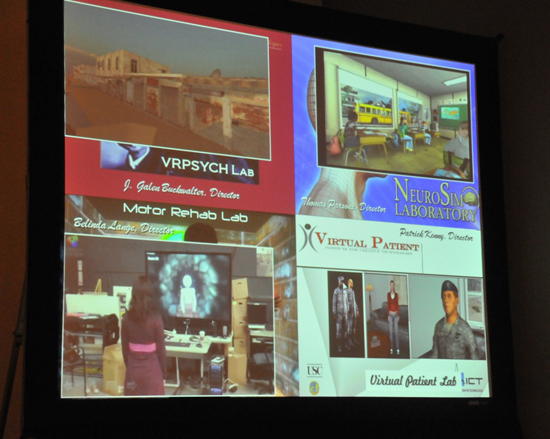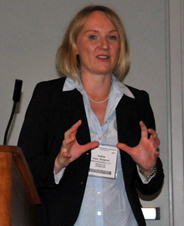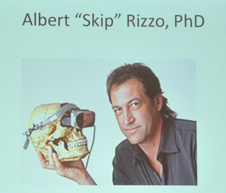American Psychological Association
119th Annual Convention
Washington D.C., August 4-7 2011
Avatar-Based Recovery Using Immersive Virtual Environments

SYMPOSIUM #2186: Ivana Steigman, M.D., Ph.D., Richard Wexler, Ph.D., Albert ("Skip") Rizzo, Ph.D.
Here today is a distinguished panel who individually and collectively represent some of the most fascinating and promising applications of virtual environments. Representing both university based laboratories and private developers, speakers treated the audience to an in-depth look at some of the most promising and popular products, with discussions about efficacy as well as demonstrations of a wide variety of computer-based applications.
Panel co-chair Richard Wexler introduced the session by observing that "VR is here... today." He cited some fascinating web metrics. Imagine, for example, 2 billion of the Earth's nearly 7 billion inhabitants are now online. There are a Billion accounts which have been created for virtual worlds, 350 million of them created within the last 6 months. One half billion people are active users of virtual worlds, and 3 billion + hours weekly are spent on Virtual game environments online. Over 500 universities are now involved in VE research and application development, and over 500 video conferencing systems have been set up to facilitate interaction between doctors and returning Veterans.
So - what is Virtual Reality? According to Jaron Lanier, who coined the term in 1987, "VR is a consciousness-noticing machine" [cit. "You Are Not a Gadget" 2010] In practice, Virtual Reality is "a computer simulated interactive environment that appears and feels to users as if they are relatively immersed in a real environment."
Its use is not restricted to gaming or mental health treatments, of course. Case in point is the IBM program in which employees are being trained using 3D virtual conference rooms and simulations of real-world work situations.
There are 4 basic types of VR - flat/public (like SecondLife), flat/secure (like inWorld Solutions offers as a VR-based clinical tool), immersion/public, and immersion/secure. Immersion (using goggles, etc.) seems "virtually better" in term of realism. Flat Secure can be HIPAA-compliant.
One emerging challenge is adaptation for use on mobile platforms.
What's an Avatar?
An avatar can be described in several ways. The word itself suggests
- Incarnation (from Hindu)
- Representation of a human operator in the virtual world (e.g., Second Life, game avatars, etc.)
- Human consciousness transferred to a virtual character (evident in several of the self-guided programs)
- A focal point for communication within virtual worlds (fully animated 3D avatars can interact, speak, gesture, travel, etc.)
There are a number of advanced applications as well.
Why does VR work? The physiological answer is "Homuncular Flexibility" and mirror neurons. The brain readily accepts the avatar as an extension of oneself. And what can it offer?
VR promotes:
-- A feeling of Sense
-- A sense of shared presence, sharing a space
-- Depth and breadth of information
-- Engagement
-- Connectiveness
-- Interaction
-- New abilities
Additionally, studies (e.g., New York Academy of Sciences) are demonstrating the value of using VR in conjunction with functional MRIs (fMRI) to further elucidate some of the neural activity within the brain or spinal cord.
Meanwhile, use has exploded (virtually) in terms of gaming:
-- 1/2 Billion people spend at least 1 hour a day playing online games
-- The average young person in a country with a strong gaming culture will spend 10,000 hours playing games by age 21 (Carnegie Melon U)
-- Collectively, "gamers have spent 5.9 million years solving virtual problems in 'World of Warcraft'" (Jane McGonigal)
In summing up this overview, Dr. Wexler noted the range of VR Applications we already see:
-- Medicine & Therapy
-- Clinical Psychology
-- Education
-- Entertainment
-- Government
-- Organizations & Workplace
-- Arbitration & conflict resolution
-- Solving Real World Problems
The benefits of Virtual Environments for Behavioral Healthcare are numerous. With more than 25 years of research & development, costs are down and access is up. "VE's are currently used for prevention, coaching, training, evaluation, treatment and rehabilitation."
Enhanced, integrated systems are "on the horizon".
For the clinician and referring physicians, there is the prospect of improved clinical outcomes and more rigorous documentation of progress. Patients see faster progress and are easily engaged, plus there are benefits in terms of convenience as well as reduced stigma. The practice owner has the potential for increased revenues and scalability, while governmental agencies can reduce both short- and long-term costs. Finally, schools too can benefit in terms of improved educational outcomes and potentially lowered costs within Special Education.
--
And with that, the next speaker was introduced: Dr. Ivana Steigman, who had been the director of clinical design and research at inWorldSolutions and recently assumed a similar role as VP of Behavioral Content and Design for Thrive Research.

Dr. Steigman began by focusing on how virtual modalities are responsive to clinical needs. On the clinician side, for example, we are looking at increased effectiveness and increased patient compliance. Tracking progress and maintaining records becomes easier too. On the patient side, they too can see increased success along with easy access to care. ("Access is a big word!") Also, VR/VE treatments are "ecologically valid" as they feel real and are highly engaging. In contrast, with the "traditional approach", patients may be seen once a week and be engaged by a variety of tasks such as recall, discussion and role-playing. But then they are on their own, untracked, until the next session.
In telemedicine applications, virtual environments may seem very much "real-world" (such as a practitioner's office, conference room, or battlefield simulation) or may be more fantasy-involved, like a Dragons and Dungeons. Applications tend to be immersive and avatar-based. At inWorld Solutions and OLIVE, they ran a pilot program in 2009 which utilized VR/VE components as part of a methadone treatment program, and entailed pre-test sessions and daily check-ins. In 2011 Thrive and OLIVE/InWorld introduced a full implementation: an Avatar Based Recovery Program. The program employs an interactive learning module as well as an online forum and VR support groups. As it is "all online", there is far less paperwork, and more accurate record-keeping.
The audience was shown a demonstration of one such application, an 8-week, VR-based AA group treatment platform. Avatars are seated in a circle. "My name is Kelly and I'm an alcoholic." "I'm Steve. I do have a bit of a problem..." I asked if all these avatars were actual, real participants. Answer: yes, and all from different cities.
Dr. Steigman spoke about the "behavioral wellness" orientation of Thrive (which is parent company to several projects and products). They look at 5 wellness domains. For each they establish a baseline, for example in the areas of sleep and stress. Step 2 is formulating a contract and goals. Session results are "tracked digitally - no more 'progress notes'."
The programs offer integrated support for cell phones, for example providing reminder calls when needed: "You haven't checked in today." Users are tracked and assessment summaries are generated. In addition to the direct treatment activities, a "psycho-educational treatment model" provides patients with interactive information modules (as is the case with many of the VR/VE programs seen throughout this and other sessions). Again, in terms of validity and engagement, the contexts may be a bar/tavern setting (for alcoholism issues), social settings, and other relevant contexts.
Next, a presentation on "Clinical Virtual Reality" applications, by Dr. Skip Rizzo, of University of Southern California and the Institute for Creative Technology.

This presentation was dense-packed with both research findings and multi-media demonstrations of some fascinating VR applications for health/mental health treatments. Beginning with a sample of one of the most promising new tools, "Virtual Iraq" from the Neuro Sim Lab, several other applications were demonstrated, including one with obvious value to Physical and Occupational Therapists. [A clip shows a girl in front of a screen with an avatar image imitating her movements and helping her to improve her range of motion. You can see a screen shot of this in the lower left of the title image, above.]
Aside from being engaging and effective, it is "cheap and easy!" to implement. Moreover, there is a real value in being able to get systems into home settings and allowing access and connection to professional clinicians, remotely.
The current project areas of the Clinical VR Research Group include:
-- Psychological Disorders, PTSD, and Pain
-- Cognitive Assessment & Rehabilitation
-- Motor Assessment & Rehabilitation
-- Virtual Patient Clinical Training
Dr. Rizzo next presented a "TechnoCentric" definition of Virtual Reality:
"Virtual Reality integrates realtime computer processing, interface technology, body tracking & sensory displays to support a user to interact with and/or become immersed in a computer generated simulated environment. Within such controllable, dynamic and interactive 3D stimulus environments, behavioral action can be motivated, recorded and measured."
In contrast, a "HumanCentric" definition of VR: "...a way for humans to interact with computers and extremely complex data in a more naturalistic fashion."
Rizzo presented an extensive list of virtual reality assets:
- Ecological validity
- Stimulus control and consistency ["the ultimate Skinner box"]
- Repetitive and hierarchical stimulus delivery possible
- Cueing stimuli for "errorless learning"
- Real time performance feedback
- Self-guided exploration and independent practice
- Stimulus and response modification contingent on user's impairments
- Complete naturalistic performance record
- Safe testing and training environment which minimizes risks due to errors
- Graduated, systematic exposure
- Distraction
- Gaming factors to enhance motivation
- Low cost functional environments that can be duplicated and distributed
Next a history of VR Application Research & Development was outlined, from 1994 - when the focus was on simple phobias - to 2011, where applications address many areas, including addiction, ADHD, Alzheimers, Autism, Balance Disorders, Cerebral Palsy, Neglect,
Pain Distraction, Phantom Limb, PTSD, Stroke, TBI, Parkinsons, Spinal Cord injury, and more. In particular, aside from simple phobias, many treatments have evolved for various forms of anxiety disorders. Recent VR applications feature such "cue exposure treatment" tools as simulated airline terminals (for fear of flying) and contextual environments which relate to social phobias, PTSD, and substance abuse. A treatment module deployed in Spain was also presented, where patients with claustrophobia were presented with a computer-generated image of a room becoming smaller and smaller.
Numerous journal articles and NIDA/NIH studies were cited, suggesting the value of stimulus control in treatment protocols using VR. In addition, the responses of the Subjects and treatment participants were instructive. In a study on smoking cessation, for example, most found the study "interesting and useful" and some noted how they "didn't realize there were so many triggers that caused them to want to smoke" and emerged determined to cut down on smoking, and/or to master the cravings to smoke. Similarly, there are contexts such as a "virtual casino" to address compulsive gambling.
Various meta-analyses have found that "VR outperforms imaginal" treatments, and is "as good as in vivo" desensitization approaches. Research also suggests that virtual treatments have lasting impact post-treatment, in the real world.
In the time remaining, the audience was treated to demonstrations of some of the applications. In addition to Virtual Iraq and Virtual Afghanistan, increasingly deployed by the military, there is also the Sim Coach for vets, which is designed to be natural and supportive. In the segment which was shown, a calm and relaxed military man is sitting on a porch with a cup of coffee. He speaks in a Southern accent and explains to the viewer that "I'm still just a piece of software, but I'm getting better all the time." He then shares that in terms of his adjustment, "things just aren't as satisfying as they used to be." He goes on to describe some of the symptoms and problems which are common to soldiers, besides himself. Not only does he educate, but he provides links (such as to AA) and can provide automated referrals to local treatment resources.
This was quite an amazing display of both the potential, and the established track record, of VR/VE applications. It has come quite a long way since the early days of simulated spiders and other phobia-oriented "exposure therapy" applications.
![[color line]](http://www.fenichel.com/moveline.gif)
2008 Convention Highlights:
Grand Theft Childhood | Opening | Malcolm Gladwell
| College Success, Love, Hate, More |
My Life With Asperger's
My Space, You Tube, Psychotherapy, Relationships... | Aaron T. Beck - 2008 | The Mind and Brain of Voters
2009 Convention Highlights:
Internet: Pathway for Networking, Connecting, and Addiction | Opening | Virtual Psychology & Therapy
| Q&A with Zimbardo
Seligman: Positive Education | Future of Internet Media | Sex, Love, & Psychology |
How Dogs Think
2010 Convention Highlights:
Online Support Groups & Applications |
Evidence & Ethical Practice | Opening Ceremony | Sir Michael Rutter: Resilience
Group Memory | Psychology in the Digital Age | Steven Hayes: What Psychotherapists Have that the World Needs Now
2011 Convention Highlights:
2011: eHealth Odyssey | Googling, Twittering, Poking | Zimbardo: Reflections + Enduring Lessons from 40 Years Ago: Stanford Prison Experiment
Avatar-based Treatments |
Canine Cognition: Chaser
| Aaron T. Beck @90
| CCBT | Seligman: Flourish |
Psychology, Technology, Virtual & Augmented Reality |
Relationships 3.0
POKE ME: How Social Networks Can Both Help and Harm Our Kids | 'Monastic' Psychology Studies | Telehealth and Telepsychology Licensure - Barriers and Possible Solutions
![[color line]](http://www.fenichel.com/moveline.gif)
![[Cyberpsychology.com]](http://www.fenichel.com/back.gif) CURRENT TOPICS in PSYCHOLOGY Q&A Teaching Tools APA 2000 2001
2002 2003 2005 2006 2007 2008 2009
CURRENT TOPICS in PSYCHOLOGY Q&A Teaching Tools APA 2000 2001
2002 2003 2005 2006 2007 2008 2009
Current Topics in Psychology Copyright ©1996-2012 Michael Fenichel
Last Updated: Friday, 18-May-2012 02:12:49 EDT


